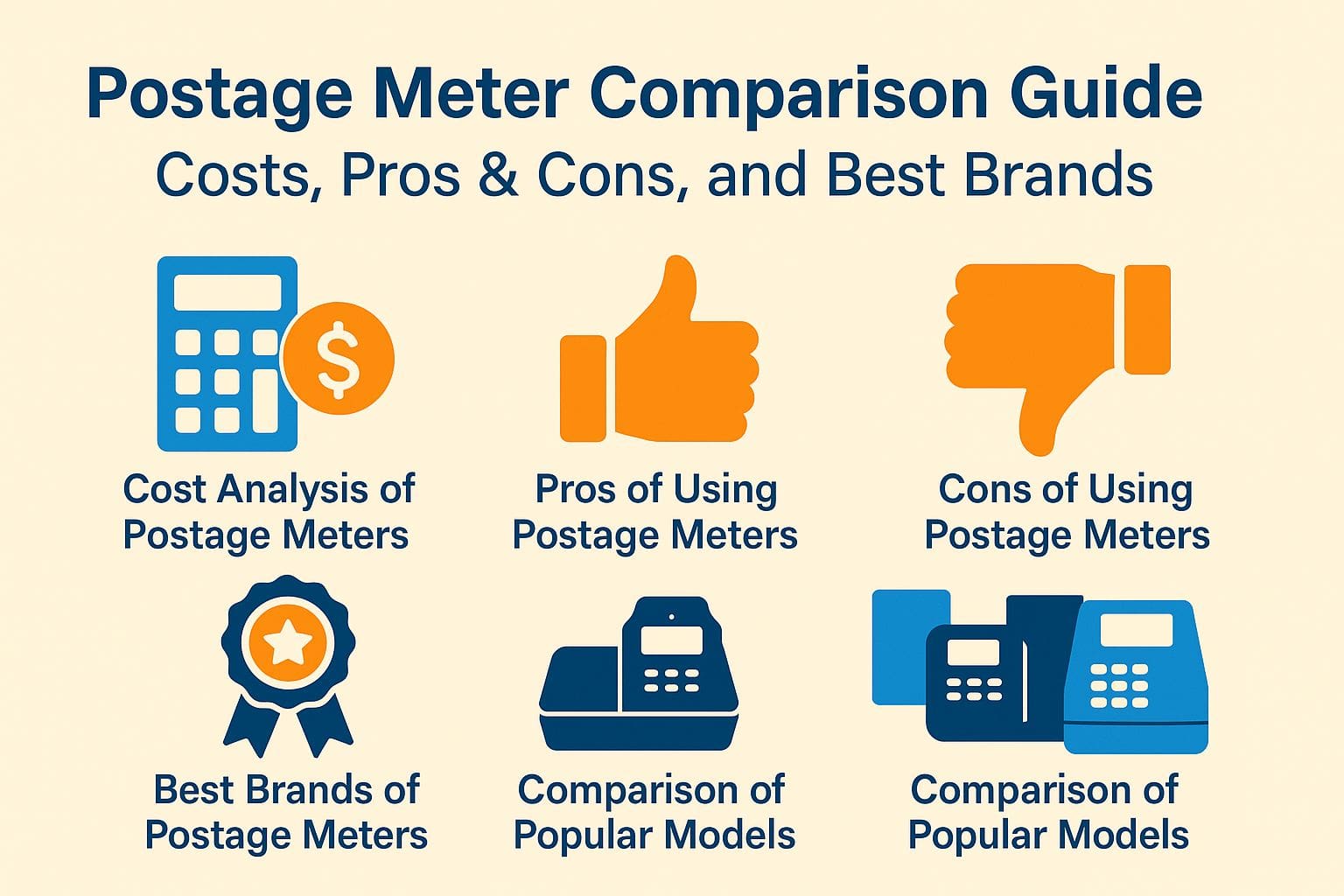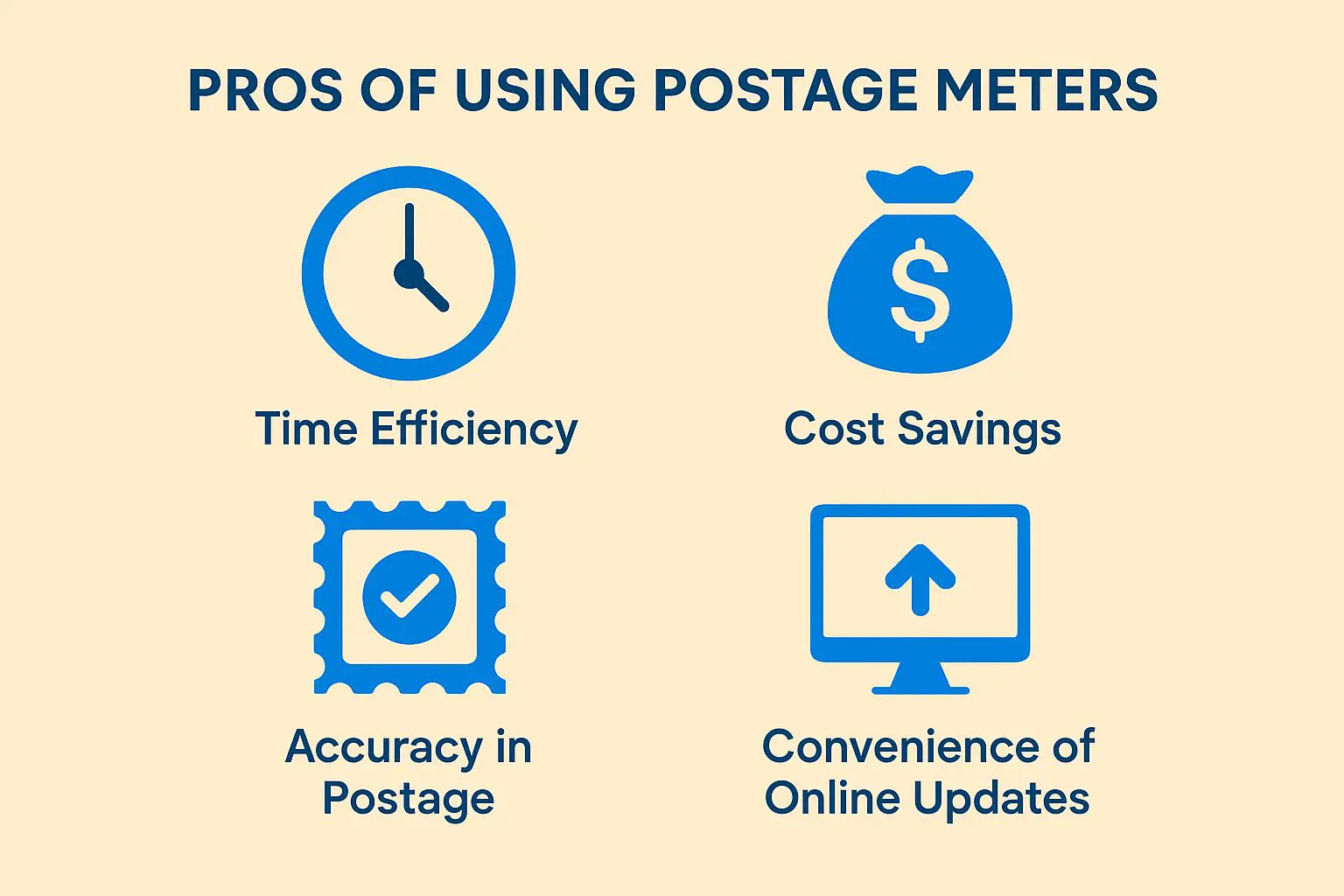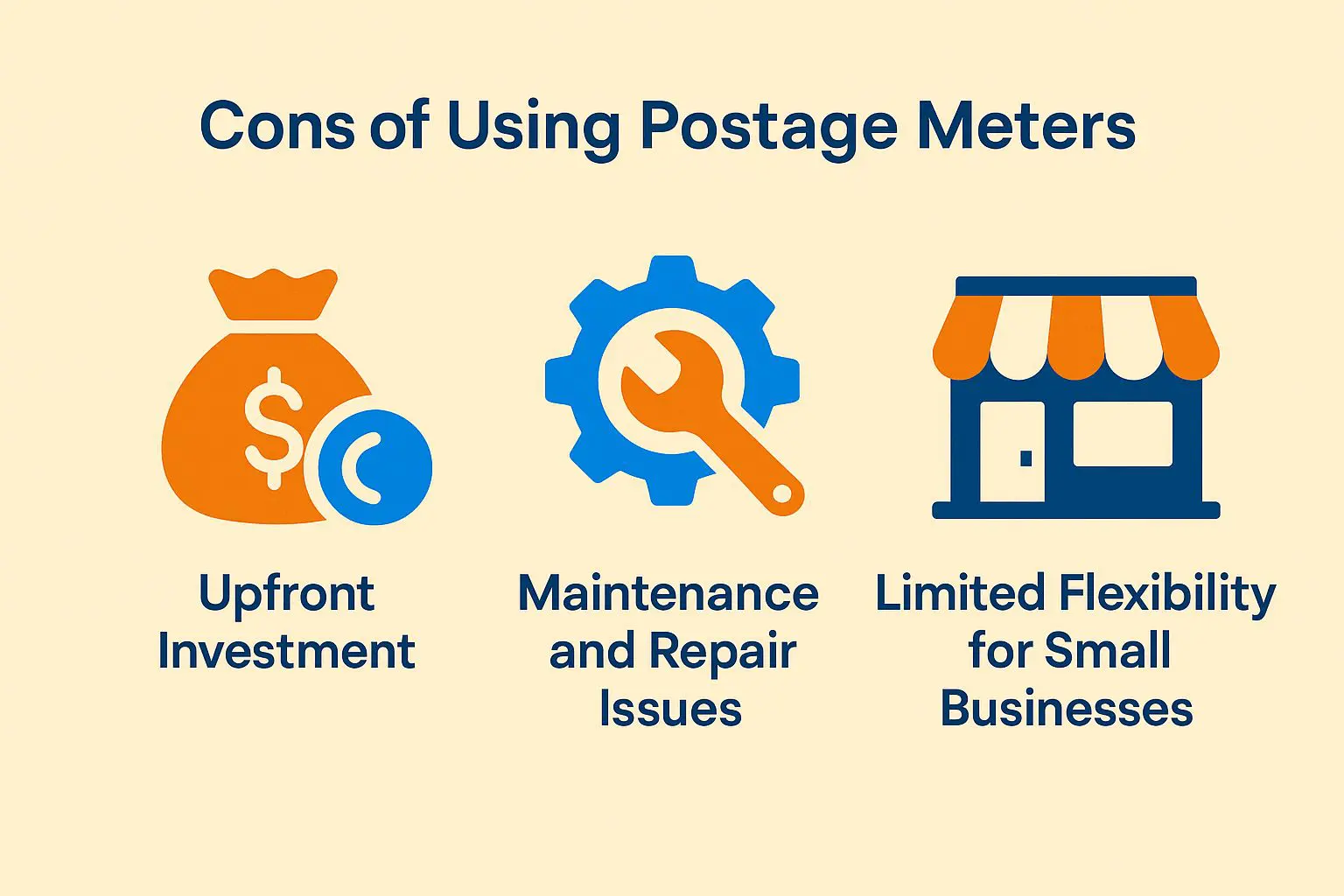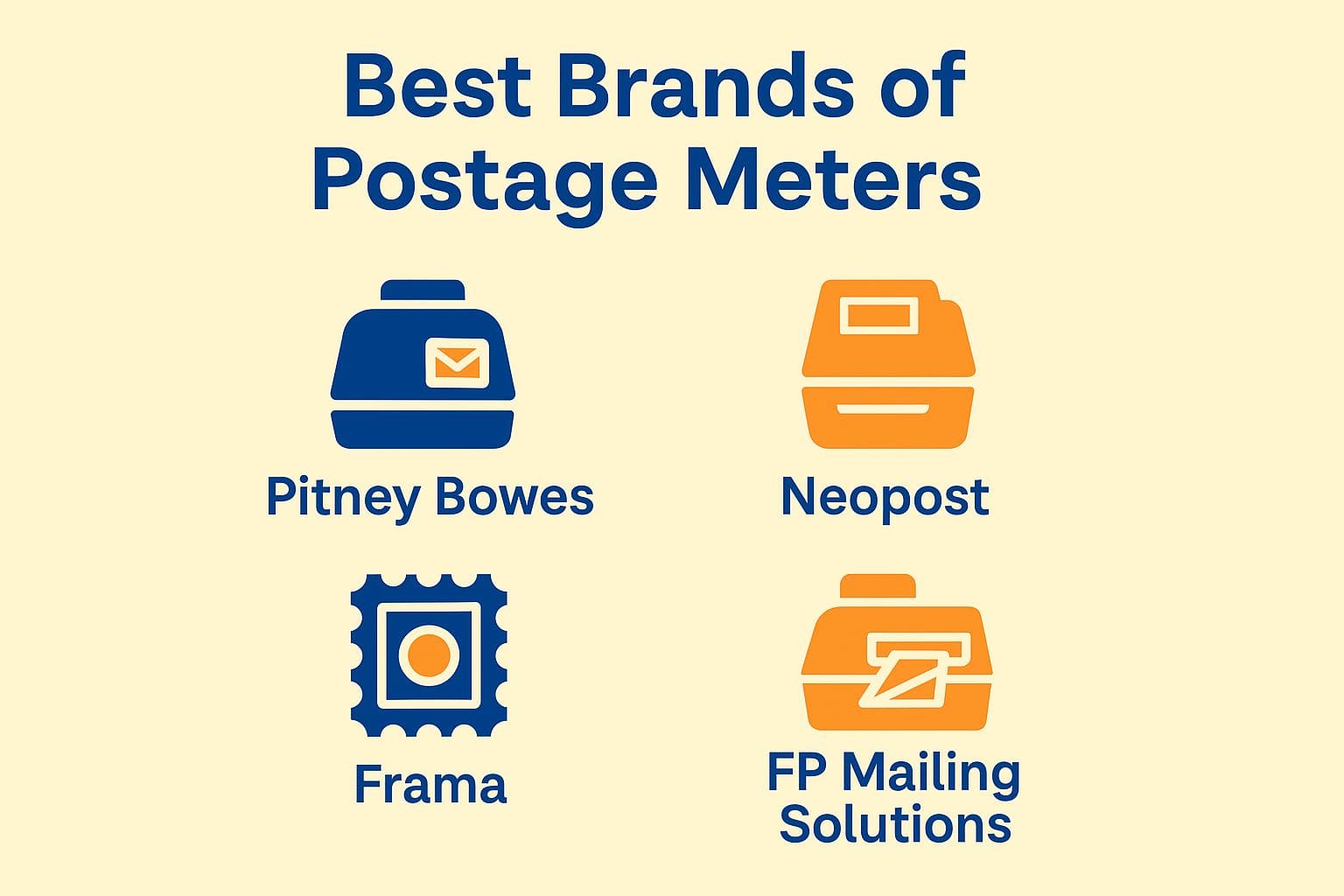
Postage Meter Comparison Guide: Costs, Pros & Cons, and Best Brands
Want to make your mailing process easier? Learning about postage meters can help you save time and money. You’ll learn what a postage meter is, how it functions, and the costs. We’ll weigh the benefits against the drawbacks, plus highlight top brands worth considering. Intrigued? Here is all the information you need to pick the right postage meter for you.
What is a Postage Meter?
A postage meter is a device that prints the right amount of postage directly onto envelopes or labels for each piece of mail.
These devices have scales to accurately measure postage and can connect to the internet for convenient use.
For example, the Pitney Bowes SendPro C Series lets users manage various types of mail and works with USPS for easier bulk mailing. The Neopost IAM 300 can track shipments and offers detailed reporting, which can help businesses monitor their mailing expenses.
Buying a USPS-approved meter helps you save time and follow postal rules, which is important for people who mail things often.
How Postage Meters Work
Postage meters work by calculating the cost of sending mail using weight and destination information, with software that follows postal rules.
These devices connect with postal services via the internet, allowing users to update postage rates automatically.
For instance, a user can log into their postage software, like Neopost or Pitney Bowes, to access the latest rates and features. Regular updates keep your postage calculations current with any postal changes.
Typically, users need to register their meter online, upload their account information, and then confirm the update process, which can usually be completed in just a few minutes, ensuring accuracy and efficiency in mailing.
Compare Quotes
Cost Analysis of Postage Meters
Knowing the cost of postage meters is important for businesses looking to reduce their mailing expenses. To get a comprehensive understanding of the pricing, explore our detailed guide on postage meter costs in 2025.
Initial Purchase Costs
Initial purchase costs for postage meters can range from $500 to $5,000 depending on features and capabilities.
Several factors influence these costs. For instance, Pitney Bowes offers models starting at around $900 with advanced tracking features, while Neopost’s entry-level options begin at approximately $600 but may lack certain functionalities.
Ongoing costs like postage refill fees and monthly service agreements can add up. For small businesses, consider leasing a meter (which can cost about $50-$150 monthly) to save upfront costs while accessing higher-end models that might otherwise be unaffordable.
Assess your mailing volume and needs to choose wisely.
Monthly Rental Fees
Monthly rental fees for postage meters typically range from $30 to $100, providing flexibility for businesses with varying mailing needs.
When considering rental versus purchase, renting often proves advantageous for small to mid-sized businesses with fluctuating mailing volumes.
Companies like FP Mailing Solutions provide rental options that remove the need for large initial payments. This lets you increase your postage capacity as your requirements expand. Renting also includes maintenance and support, which can save you from unexpected repair costs.
If your mailing volume is consistent and high, purchasing might be more economical in the long run, as it typically results in lower costs per piece over time.
Supplies and Maintenance Costs
Ongoing costs such as ink cartridges and maintenance can add an additional $100 to $300 annually to the total expenditure of owning a postage meter.
Ink cartridges for common brands like Neopost vary in price, averaging $50-$75 each, depending on color and yield. Regular maintenance checks may cost around $100 annually, while tape rolls are approximately $20 for a pack of five.
To minimize costs, consider investing in high-yield cartridges, which, although pricier upfront, can reduce the frequency of replacements. Setting up a regular maintenance plan can extend the lifespan of your postage meter, which can reduce costs over time.
Long-term Financial Benefits
Investing in a postage meter can lead to long-term financial benefits, reducing mailing costs by up to 20% compared to traditional postage stamps.
Besides lowering postage costs, a postage meter saves time by automating label printing and tracking postage expenses.
For example, using a machine like the Pitney Bowes SendPro, users can quickly print postage directly from their desks without a trip to the post office. This reduces manual work and makes mail handling more efficient, giving businesses the chance to assign staff time to other tasks.
Many meters allow you to monitor postage expenses online, which helps with budgeting and makes them more cost-effective.
Compare Quotes
Pros of Using Postage Meters
Postage meters provide many benefits that improve mailing processes for businesses of any size. For businesses interested in investing in this technology, understanding how postage meter prices have evolved in recent years can be crucial.

Time Efficiency
Businesses can save hours each week by using postage meters, streamlining the mailing process significantly.
For instance, a company that typically spends five hours organizing mail can cut this down to about 30 minutes with a postage meter. By printing label details in advance and measuring package weights on their own, these devices remove the need for manual math and going to the post office.
Consider using tools like Neopost or Pitney Bowes, which also offer additional features such as tracking and reporting. This efficiency saves time and cuts down on frustration, letting staff concentrate on more important work.
Cost Savings
The use of postage meters can lead to substantial cost savings, especially for companies sending large volumes of mail.
By switching to a postage meter, businesses can save up to $1,000 annually on postage costs.
For example, a company that previously used stamps to mail 1,000 letters a month at $0.55 each would spend $660 yearly. With a postage meter, they may pay a discounted rate of $0.50 per letter, reducing the cost to $600.
It eliminates the labor of buying and affixing stamps, improving efficiency. Purchasing a postage meter often pays for itself within a year, making it a sensible choice for frequent mail senders.
Accuracy in Postage
Postage meters calculate postage costs correctly, helping avoid paying too much or getting postal fines.
They function by automatically determining the exact weight and type of mail, then printing a label that shows this information.
For effective use, choose a reputable postage meter like Pitney Bowes or Neopost, both of which offer models that connect with your shipping software.
Regularly check for software updates to maintain accuracy, and train your team on proper usage to avoid mistakes that could lead to penalties.
This saves money and makes the mailing process simpler, ensuring on-time deliveries.
Convenience of Online Updates
Postage meters allow for immediate online updates to postage rates, ensuring compliance with the latest postal regulations.
Most modern postage meters, such as the Pitney Bowes SendPro and Neopost IS-900, connect directly to online platforms, enabling real-time updates. Users can set these devices to automatically refresh rates weekly or more frequently, depending on shipping volume and requirements.
For example, the SendPro system provides alerts via its mobile app, allowing you to adjust settings instantly. Connecting these meters with shipping software such as ShipStation helps simplify processes, lowering the chances of using old rates that might cause fines or misplaced packages.
Cons of Using Postage Meters
Postage meters offer many benefits, but they also have some downsides that businesses need to think about.

Upfront Investment
The upfront cost of a postage meter can be high, often discouraging smaller businesses from adopting this technology.
Businesses should consider both immediate costs and long-term savings.
For instance, a basic meter might cost around $300, while more advanced models with features such as tracking and reporting can range from $600 to $1,200. Over time, these meters can save significant money by reducing postage costs and streamlining mailing processes.
Many businesses report savings of up to 20% on postage, which often offsets the initial purchase within the first year. Using software like Pitney Bowes or Neopost can increase productivity, making it a worthwhile investment.
Maintenance and Repair Issues
Regular maintenance and potential repair issues can add unexpected costs to using postage meters, affecting overall value.
Postage meters from brands like Pitney Bowes tend to be reliable, often requiring minimal maintenance, while others, like Neopost, may experience more frequent technical issues.
Annual maintenance costs can vary, typically ranging from $100 to $500 depending on usage and support plans.
For example, a basic service plan with Pitney Bowes costs around $200, covering field repairs and routine checks. Neopost’s plans can cost as much as $400 if you choose the full coverage option.
Knowing the related expenses helps you make better choices about money.
Limited Flexibility for Small Businesses
Postage meters may limit flexibility for small businesses, particularly those with fluctuating mailing volumes.
Seasonal businesses, such as retail shops or e-commerce platforms, can benefit from flexible solutions like pay-per-use mailing services. These services allow you to pay only for postage when you send items, reducing upfront costs associated with a postage meter.
For example, using platforms like Stamps.com or Pitney Bowes can provide you with access to discounted rates without the commitment of a meter. This approach lets you scale your operations based on current mailing needs, ensuring you avoid unnecessary expenses during quieter periods.
Compare Quotes
Best Brands of Postage Meters
Picking a reliable postage meter brand is important for dependable and affordable mail processing. Choosing the right brand can be challenging, as there are several factors to consider such as cost, features, and service quality. Our Buyer’s Guide to the Best Postage Meter Companies (as mentioned in our comprehensive review) provides essential insights to help you make an informed decision.

Pitney Bowes
Pitney Bowes is a market leader known for its advanced postage meters that cater to businesses of all sizes.
Their postage meters offer a range of features suited for different business needs.
- The SendPro C-series, priced around $300, is excellent for small businesses due to its ease of use and compact design.
- For mid-sized companies, the SendPro P-Series, starting at $1,200, provides advanced tracking and analytics.
- Larger enterprises often opt for the SendPro Enterprise, which includes bulk mailing capabilities and advanced mail management for around $5,000.
Testimonials show that the interfaces are easy to use and customer support is dependable, helping companies to make their mailing processes simpler and more efficient.
Neopost
Neopost offers innovative solutions, focusing on high-volume mailing systems that integrate seamlessly with modern business needs.
Neopost’s pricing structure is generally tiered based on the volume of items mailed and the features selected, starting around $50 per month.
Notable features include:
- automatic tracking
- customizable shipping labels
- high-speed envelope feeders
Customer satisfaction ratings average around 4.5 stars due to their strong customer support and user-friendly interface. This combination helps businesses manage their mailing tasks faster, reducing costs and improving accuracy and reliability.
Frama
Frama is popular for its simple postage meters, often selected by small and medium-sized businesses.
Frama offers two primary models: the Matrix F and Matrix F2.
The Matrix F is ideal for small businesses with a price starting around $1,200 and includes features like intuitive touch screens and customizable postage options.
For growing businesses, the Matrix F2, priced at about $1,800, offers improved features, such as detailed reports and a built-in accounting module.
Both models connect to the cloud, letting users print postage from any device. This simplifies tasks and makes sure they follow postal rules.
FP Mailing Solutions
FP Mailing Solutions specializes in affordable postage meters designed to meet the needs of budget-conscious businesses.
These meters cut shipping expenses and make mailing easier. Key features include automatic postage calculations and user-friendly interfaces, which help businesses save time.
For instance, the FP-500 postage meter offers a compact design ideal for small offices and starts at just $200. Customers frequently highlight the reliability and ease of use in reviews, noting how it improved their mailing efficiency.
By investing in these solutions, businesses can significantly cut down on postage expenses while enhancing workflow.
Comparison of Popular Models
Before choosing a postage meter, consider comparing various models by checking their features, prices, and user reviews. For a comprehensive understanding, you might want to explore our complete buyer’s guide to the best postage meter companies available on the market.
Features to Consider
Key features to consider when selecting a postage meter include speed, accuracy, and integrated software capabilities.
Speed is important; for example, choose models that handle up to 60 letters per minute, which can greatly increase productivity.
Meeting USPS standards is important, and the included software makes it easy to create and track labels. Common models such as the Pitney Bowes SendPro C Series include features that simplify their connection with shipping systems, allowing for updates as they happen.
When evaluating options, consider additional features like Wi-Fi connectivity for easier network access and mobile capabilities, which make managing postage on-the-go efficient and user-friendly.
Customer Reviews and Ratings
Customer reviews and ratings can give useful information about how well different postage meter brands work and how trustworthy they are.
Platforms like Trustpilot and Consumer Reports are excellent for gathering user feedback.
For example, when comparing two popular brands, you might find that Brand A has a user rating of 4.5 stars on Trustpilot with comments highlighting its durability and ease of use. In contrast, Brand B, rated at 3.8 stars, may receive critiques about its customer service.
By reviewing such feedback, you can make a more informed decision, select a model that fits your needs, and even identify common issues that users have encountered.
Jordan Blake is a B2B strategist and contributor at Price It Here, where she shares expert advice on buying decisions and business growth. She holds a Bachelor’s in Business Administration from the University of Michigan and an MBA from Northwestern’s Kellogg School of Management.
With over a decade of experience in procurement and vendor strategy, Jordan helps businesses save money and scale smarter. Her practical insights make her a trusted voice for entrepreneurs seeking cost-effective, results-driven solutions.

